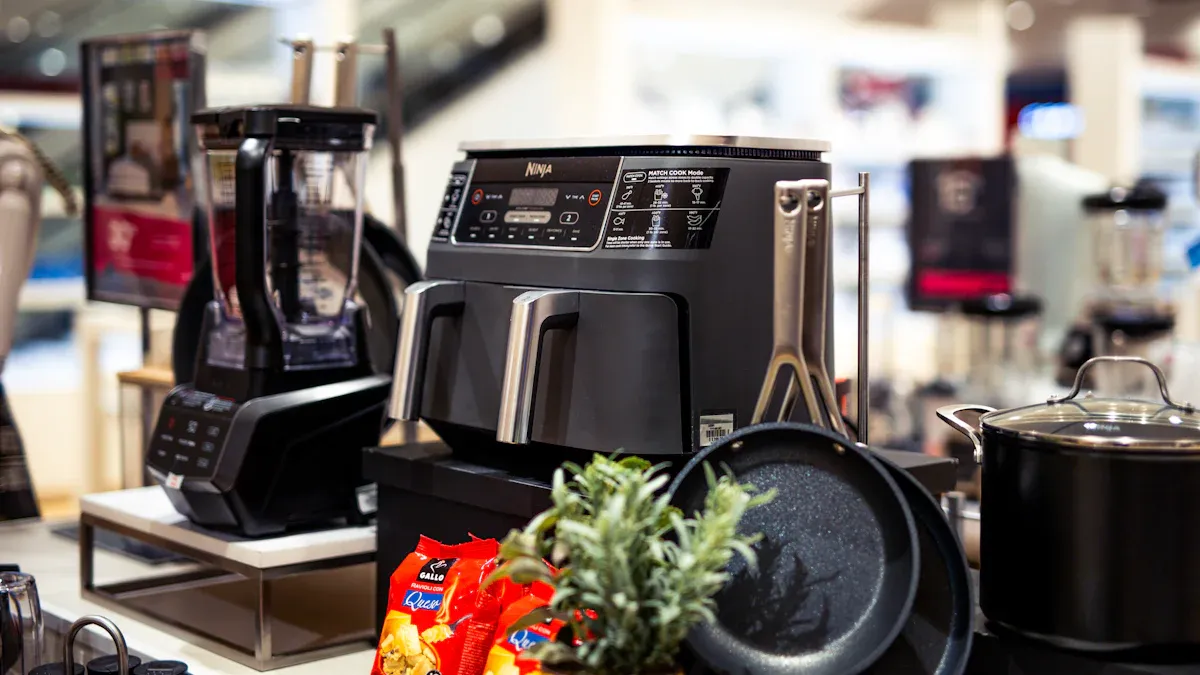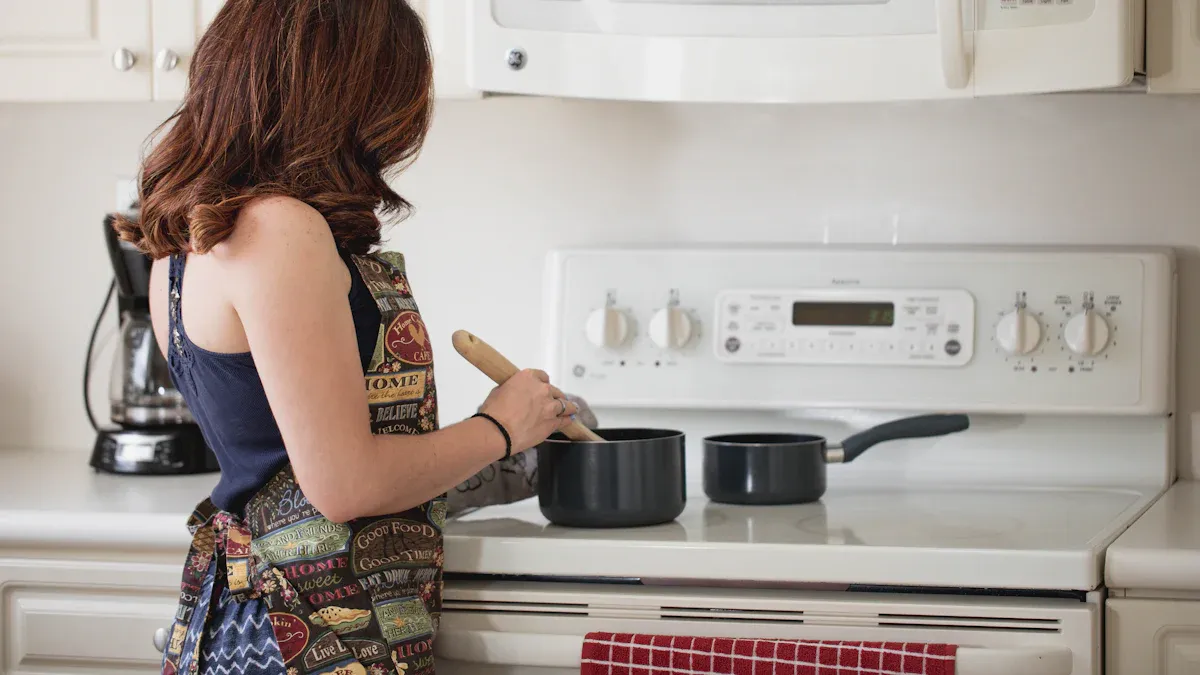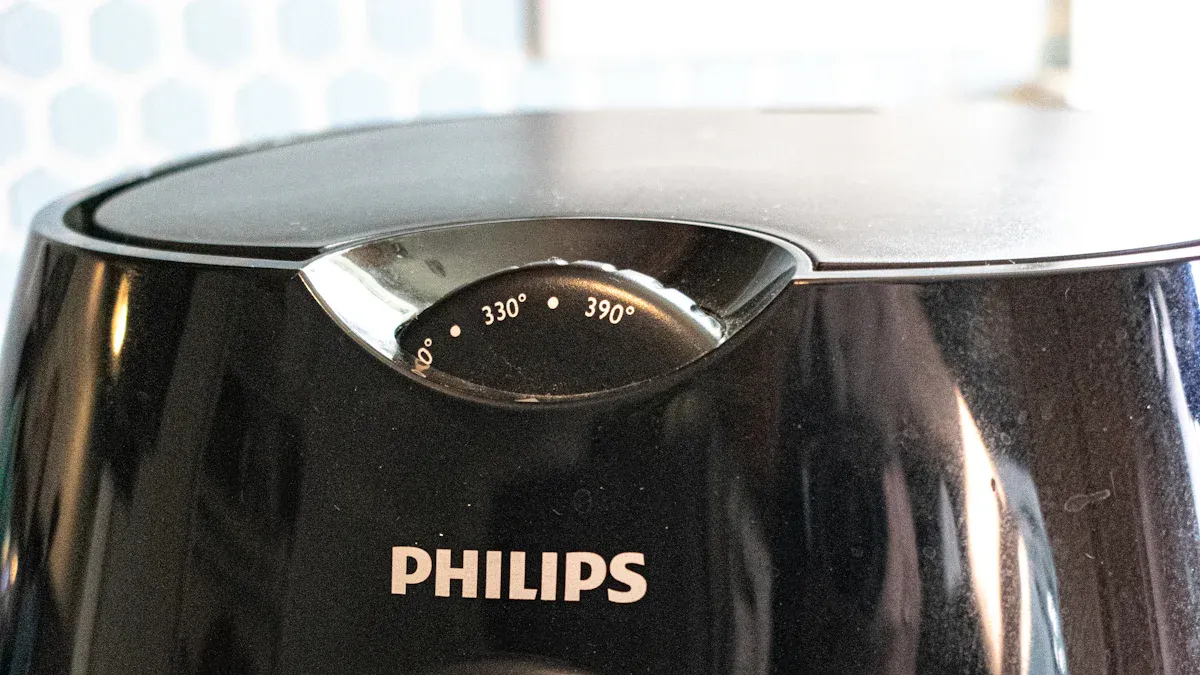
Choosing the right household air fryer is essential and varies based on individual needs. Factors such as cooking habits, household size, and budget are important considerations. The popularity of air fryer ownership has surged, increasing from 0.01 units per household in 2018 to 0.04 in 2023. Options like the pressure cooker air fryer and the oil free air fryer oven provide energy-efficient cooking solutions, allowing users to save up to 68p per use compared to traditional ovens. Additionally, the electric oil free fryer is a great choice for those looking to enjoy healthier meals without the added oil.
Understanding Household Air Fryers
How Air Fryers Work
Air fryers operate by circulating hot air around food to cook it evenly. A built-in fan pushes the heated air, creating a convection effect that mimics frying without submerging food in oil. This process produces crispy textures similar to deep frying but with significantly less fat. Most household air fryers use a heating element powered by electricity, making them energy-efficient appliances.
The efficiency of air fryers becomes evident when comparing their energy consumption to traditional ovens. For example:
| Item | Oven Cost (pence) | Air Fryer Cost (pence) |
|---|---|---|
| Cooking Chips | 35.38 | 14.62 |
| Cooking Chicken Thighs | 35.38 – 47.16 | 16.08 – 20.47 |
A typical 1,500 W air fryer costs about 51p per hour, translating to approximately 17p per 30-minute use. In contrast, a standard 2,200 W electric oven costs around 85p per hour. These savings have led 32% of U.K. air fryer owners to report lower energy bills.
Benefits of Using an Air Fryer
Air fryers offer numerous advantages, making them a valuable addition to any kitchen. They use significantly less oil than traditional frying methods, reducing fat and calorie intake. This healthier cooking approach can lower the risk of chronic diseases linked to high-fat diets. Additionally, air fryers heat up quickly and cook food faster than conventional ovens, saving time and energy.
Another benefit is their versatility. Air fryers can bake, broil, roast, and reheat, allowing users to prepare a variety of meals. They also emit less heat into the kitchen, making them ideal for warm weather. Cleaning is straightforward since most models feature removable, dishwasher-safe parts. Unlike deep fryers, air fryers avoid creating greasy messes, simplifying kitchen maintenance.
By promoting healthier eating habits and offering convenience, a household air fryer can transform daily cooking routines.
Types of Household Air Fryers

Basket-Style Air Fryers
Basket-style air fryers are among the most popular choices for households. These models feature a pull-out basket where food is placed, allowing hot air to circulate evenly for crisp and delicious results. In South Korea, 64% of respondents in 2021 preferred this type of air fryer, highlighting its widespread appeal. Users often choose basket-style air fryers for their cost-efficiency, with 53% of U.K. owners citing this as a key reason for their purchase. These air fryers excel in frying, baking, roasting, and grilling, making them versatile tools for everyday cooking. Their compact design also suits smaller kitchens, making them ideal for individuals or couples.
Tip: To maximize performance, avoid overcrowding the basket. This ensures even cooking and better results.
Air Fryer Ovens
Air fryer ovens combine the functionality of a traditional oven with the benefits of air frying. These models typically have larger capacities, making them suitable for families or those who cook in bulk. A comparison of energy usage shows that the Salter Dual Cook Pro Air Fryer uses 1.75 kWh per hour, costing £0.49, while a domestic electric oven can cost up to £1.40 per hour. This efficiency makes air fryer ovens a practical choice for energy-conscious households. Additionally, they often include multiple racks, allowing users to cook different dishes simultaneously.
Multi-Function Air Fryers
Multi-function air fryers cater to those seeking versatility in a single appliance. These models can bake, roast, dehydrate, and grill, appealing to urban households with limited kitchen space. By 2025, 50% of air fryer sales are expected to come from multi-functional models, reflecting growing consumer demand. They also offer significant energy savings, with typical costs around 17p per use compared to 85p for an electric oven. For households aiming to reduce energy bills, these air fryers provide an excellent solution.
Features to Consider in a Household Air Fryer
Size and Capacity
Choosing the right size and capacity for a household air fryer depends on several factors. The number of people in the household plays a significant role. A smaller air fryer suits singles or couples, while larger models accommodate families or meal preppers. The type of dishes prepared also influences the choice. For example, baking or roasting larger items requires a spacious air fryer. Counter space is another consideration. Compact models fit well in kitchens with limited space, while larger units may require more room. Usage frequency matters too. Frequent users benefit from higher-capacity models that handle larger batches efficiently.
Air fryer ownership has steadily increased, reflecting their growing popularity. In 2018, households owned an average of 0.01 units, which rose to 0.04 units by 2023. This trend highlights the importance of selecting a model that matches individual needs.
Ease of Cleaning and Maintenance
Ease of cleaning is a critical factor when evaluating household air fryers. Many models feature removable parts that are dishwasher-safe, simplifying the cleaning process. Streamlined maintenance designs reduce user effort, making air fryers convenient for daily use. Consumer Reports emphasize the importance of cleaning both the interior and exterior during product evaluations.
| Feature | Benefit |
|---|---|
| Removable Parts | Dishwasher-safe for easy cleaning |
| Maintenance Process | Streamlined for minimal user effort |
These features ensure that air fryers remain hassle-free and ready for use, even after preparing messy dishes.
Advanced Features and Controls
Advanced features enhance the functionality of household air fryers. Smart controls, such as preset cooking modes and touchscreens, improve the cooking experience for users. Statistics show that 72% of users report a positive impact on their cooking routines due to these features. Familiarity with smart air fryers is growing, with 42% of users aware of their benefits.
| Statistic | Value |
|---|---|
| Improved cooking experience | 72% positive impact |
| Familiarity with smart air fryers | 42% familiar, 58% not familiar |
These features allow users to experiment with different recipes and cooking techniques, making air fryers versatile tools in modern kitchens.
Comparing Air Fryers to Other Appliances
Air Fryers vs. Toaster Ovens
Air fryers and toaster ovens serve similar purposes but differ in performance and efficiency. Air fryers generally consume less energy than toaster ovens, making them a more eco-friendly choice. They also cook food faster. For instance, air fryers reduce cooking times by an average of 3 minutes and 46 seconds when achieving 45% moisture loss compared to toaster ovens. This speed can be crucial for busy households.
Air fryers excel in delivering crispy textures. On average, they produce 68.7% crispy fries, outperforming toaster ovens, which achieve 65.6%. Basket-style air fryers also provide more consistent results, while air fryer toaster ovens may show variability in performance. These differences make air fryers a preferred option for those seeking quick, reliable, and energy-efficient cooking.
Note: Toaster ovens may still be a better choice for baking or reheating larger dishes due to their spacious interiors.
Air Fryers vs. Deep Fryers
Air fryers and deep fryers differ significantly in health benefits and cooking methods. Air fryers use hot air circulation to cook food, resulting in a much lower fat content. For example, air-fried foods contain only 0.39 grams of fat per 100 grams, compared to 13.2 grams in deep-fried foods. This makes air fryers a healthier alternative for preparing meals.
| Cooking Method | Fat Content (g per 100g) | Cooking Time (minutes) |
|---|---|---|
| Deep Frying | 13.2 | Varies |
| Air Frying | 0.39 | Faster |
Air fryers also cook faster than deep fryers, saving time in the kitchen. While deep fryers may offer a traditional taste and texture, air fryers provide a modern solution for health-conscious households. A household air fryer can transform cooking routines by promoting healthier eating habits without sacrificing flavor.
Budgeting for a Household Air Fryer
Affordable Options
Affordable air fryers provide an excellent entry point for those new to this appliance. These models are typically priced under $100 and offer capacities of 2-4 quarts, making them ideal for singles or couples. They are highly energy-efficient, costing approximately 17p per use compared to 85p for a standard oven. A typical 1,500 W air fryer uses around 51p per hour, but most cooking sessions last only 30 minutes, further reducing costs.
Consumers can save significantly on energy bills by switching to an air fryer. For example, cooking chips in an air fryer costs just 14.62p compared to 35.38p in an oven. Similarly, preparing chicken thighs costs 16.08-20.47p in an air fryer versus 35.38-47.16p in an oven. These savings allow users to break even on a £150 air fryer within six months of daily use.
Tip: Affordable models often lack advanced features but still deliver excellent results for basic cooking needs.
Premium Models
Premium air fryers, priced above $200, cater to larger households or those seeking advanced functionality. These models typically offer capacities of 6+ quarts, suitable for families or batch cooking. They feature superior build quality, precise temperature controls, and advanced heating elements, ensuring consistent cooking results.
| Price Range | Typical Capacity | Suitable For |
|---|---|---|
| Under $100 | 2-4 quarts | 1-2 people |
| $100-$200 | 4-6 quarts | 2-4 people |
| $200+ | 6+ quarts | 4+ people or batch cooking |
Expensive models often include longer warranties, ranging from 2-3 years, compared to the 1-year warranty of budget options. While the initial investment is higher, the durability and reliability of premium air fryers make them a worthwhile choice for frequent users.
Note: Premium models may not cook faster than mid-range options, but their advanced features enhance the overall cooking experience.
Recommendations for Different Household Sizes

Air Fryers for Singles or Couples
Singles or couples benefit greatly from compact air fryers. These models fit well in small kitchens and consume less energy than traditional ovens. They are ideal for preparing single servings, avoiding the inefficiency of larger ovens designed for bulk cooking.
- Compact design saves counter space.
- Energy-efficient operation reduces electricity costs.
- Perfect for quick meals like fries, chicken tenders, or roasted vegetables.
For those living alone or with a partner, a 2-4 quart air fryer offers the perfect balance of size and functionality. It ensures food cooks evenly without wasting energy or space.
Tip: Look for models with basic features like temperature control and a timer. These are sufficient for most small-scale cooking needs.
Air Fryers for Families
Families require air fryers with larger capacities to accommodate multiple servings. Models with 6+ quarts are ideal for preparing meals for four or more people. These air fryers often include features like dual baskets or multiple racks, allowing users to cook different dishes simultaneously.
Larger air fryers also save time by reducing the need for multiple cooking batches. Families can prepare healthier meals quickly, making these appliances a practical choice for busy households. The growing popularity of air fryers reflects their suitability for families. By 2026, the average household ownership is expected to reach 0.05 units, up from 0.01 in 2018.
Note: Families should consider models with dishwasher-safe parts for easier cleaning after large meals.
Air Fryers for Meal Preppers
Meal preppers benefit from air fryers that combine speed, capacity, and versatility. These appliances cook food quickly by circulating hot air, making them ideal for batch cooking. Models with automatic programs simplify the preparation of various foods, from roasted vegetables to baked goods.
- Air fryers range in size from 2 to 11 quarts, catering to different cooking needs.
- A typical 1,500 W air fryer costs about 17p per use, significantly less than an oven.
- Daily use of a £150 air fryer can lead to breaking even within six months.
A recent survey revealed that 32% of U.K. air fryer owners noticed lower energy bills. Over a third reported cooking more at home and ordering fewer takeaways. This highlights the financial and lifestyle benefits of owning an air fryer for meal prepping.
Tip: Choose a model with a larger capacity and multiple cooking functions to maximize efficiency.
Maintenance Tips for Household Air Fryers
Cleaning the Basket and Accessories
Proper cleaning of the basket and accessories ensures the air fryer remains efficient and safe to use. Regular cleaning after each use prevents grease and food particles from accumulating. This practice also reduces the risk of unpleasant odors and ensures food safety. Wiping down the basket and accessories immediately after cooking greasy foods is especially important.
Many air fryer models, such as the Elite Gourmet, feature dishwasher-safe removable parts. These parts simplify the cleaning process and save time. For those without a dishwasher, soaking the basket in warm, soapy water for a few minutes loosens stuck-on food. A soft sponge or brush can then be used to scrub away any residue. Avoid using abrasive materials, as they may damage the non-stick coating.
Tip: Using liners or parchment paper can catch drippings and reduce mess, making cleanup faster and easier.
Preventing Odors and Build-Up
Preventing odors and build-up in an air fryer requires consistent maintenance. Wiping down the interior after each use removes grease and food particles before they harden. Overcrowding the basket during cooking can lead to splatter, increasing the need for cleaning. Cooking in smaller batches minimizes mess and ensures even cooking.
Regular cleaning extends the lifespan of the appliance and keeps it operating efficiently. Liners or parchment paper can also help by catching grease and crumbs. These simple steps make future cleanings less time-consuming and maintain the air fryer’s performance.
Note: Neglecting regular maintenance can lead to odors, reduced efficiency, and even mechanical issues over time.
Choosing the right air fryer involves evaluating size, capacity, and features. Matching the appliance to household needs ensures satisfaction. Features like Wi-Fi and Bluetooth improve user experience, with 71.5% reporting higher satisfaction. Multi-cooking functions, expected to account for 50% of sales by 2025, enhance versatility. Prioritizing these features transforms cooking routines.
Tip: Opt for energy-efficient models to save costs. For instance, a 1,500 W air fryer costs only 17p per use compared to 85p for an electric oven.
FAQ
What foods can be cooked in an air fryer?
Air fryers can cook a variety of foods, including fries, chicken, vegetables, fish, and baked goods. They also reheat leftovers effectively without making them soggy.
Do air fryers require preheating?
Most air fryers do not require preheating, but preheating can improve cooking results for certain recipes. Check the user manual for specific recommendations.
Are air fryers safe for children to use?
Air fryers are generally safe for older children under supervision. The exterior remains cool, but the basket and interior can get hot during use.
Tip: Teach children to handle the basket carefully to avoid burns.


